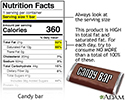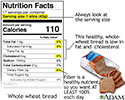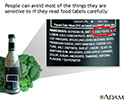Food labeling
Nutrition labeling
Food labels contain a great deal of information on most packaged foods. The FDA has proposed updates to the current Nutrition Facts label.
Function
The serving size on the label is based on an average portion size. Similar food products have similar serving sizes to make comparing products easier. The serving size on the label does not always correlate with a “healthy” serving size. Most of the time, it does not match the serving size on the diabetic exchange list. The United States Food and Drug Administration (FDA) has proposed making changes to the food labels that may correct these problems.
AMOUNTS PER SERVING
The total calories and the calories from fat are listed. These numbers help consumers make decisions about fat intake. The list of nutrients includes total fat, trans fat, saturated fat, cholesterol, sodium, total carbohydrate , dietary fiber , sugars , and protein . These nutrients are important to our health. Their amounts are given in grams (g) or milligrams (mg) per serving to the right of the nutrient.
Carbohydrate
Carbohydrates are one of the main nutrients in our diet. They help provide energy for our body. There are three main types of carbohydrates found i...

Fiber
Fiber is a substance found in plants. Dietary fiber, which is the type of fiber you can eat, is found in fruits, vegetables, and grains. It is an i...

Sugars
Carbohydrates are one of the main nutrients in our diet. They help provide energy for our body. There are three main types of carbohydrates found i...

Protein
Proteins are the building blocks of life. Every cell in the human body contains protein. The basic structure of protein is a chain of amino acids. ...

VITAMINS AND MINERALS
Only 2 vitamins (A and C) and 2 minerals (calcium and iron) are required on the food label. But, when vitamins or minerals are added to the food, or when a vitamin or mineral claim is made, those nutrients must be listed on the nutrition label. Food companies can voluntarily list other vitamins and minerals in the food.
PERCENT DAILY VALUE
The amounts of vitamins and minerals are listed as a Percent Daily Value on the nutrition label. The Percent Daily Value for vitamins and minerals gives a general idea of how much of a vitamin or mineral 1 serving of the food contributes to the total daily requirement. For example, if the Percent Daily Value for vitamin C of all the foods you eat in a day adds up to 100%, you are getting the recommended amount of vitamin C.
Vitamin C
Vitamin C is a water-soluble vitamin. It is needed for normal growth and development. Water-soluble vitamins dissolve in water. Leftover amounts of...

Food Sources
The United States government requires food labels on most packaged foods. The label offers complete, useful, and accurate nutrition information. The government encourages food manufacturers to improve the quality of their products to help us make healthier food choices. The consistent format helps you directly compare the nutritional content of various foods. Food labels are called "Nutrition Facts."
Recommendations
The Percent Daily Value section shows how a food fits into your overall daily diet. The value of the nutrient is given in percentages. The Percent Daily Value gives the food's nutritional content based on a 2,000-calorie diet. You can use this to quickly compare foods and see how the amount of a nutrient in a serving of food fits into a 2,000-calorie diet.
For example, a food that has 13 grams of fat with a Percent Daily Value of 20% means that 13 grams of fat is 20%, or one-fifth, of the total daily fat recommended for a person who eats 2,000 calories per day.
Near the bottom of some food labels, you will see a list of 6 nutrients and the recommended daily intakes. The daily values are listed for 2,000-calorie and for 2,500-calorie diets. Your daily values may be higher or lower depending on your calorie needs. This information is not required if the label is too small.
If they are included, the amounts of the first 4 nutrients near the bottom of the label -- total fat, saturated fat, cholesterol, and sodium -- are maximum amounts. That is why the list says "less than" before the number. The amounts of total carbohydrate and dietary fiber are minimum amounts. This is exactly the same on all food labels that carry it. You can use it as a reference.
NUTRIENT CONTENT CLAIMS
A nutrient content claim is a word or phrase on a food package that makes a comment about the nutritional value of the food. The claim will mean the same for every product. The following are some approved nutrient claims.
Calorie terms:
- Low-calorie: 40 calories or less per serving.
- Reduced-calorie: At least 25% fewer calories per serving when compared to a similar food.
- Light, Lite: One-third fewer total calories or 50% less fat per serving. If more than half the calories are from fat, the fat content must be reduced by 50% or more.
Sugar terms:
- Sugar-free: Less than 1/2 gram of sugar per serving.
- Reduced sugar: At least 25% less sugar per serving when compared to a similar food.
Fat terms:
- Fat-free: Less than 1/2 gram of fat per serving.
- 100% fat free: Meets the requirements for fat free.
- Low-fat: 3 grams of fat or less per serving.
- Reduced-fat: At least 25% less fat when compared with a similar food.
Cholesterol terms:
- Cholesterol-free: Less than 2 milligrams of cholesterol per serving and 2 grams or less of saturated fat per serving.
- Low cholesterol: 20 milligrams or less of cholesterol per serving and 2 grams or less of saturated fat per serving.
Sodium terms:
- Sodium-free: Less than 5 milligrams of sodium per serving.
- Salt-free: Meets the requirements for sodium-free.
HEALTH CLAIMS
The Food and Drug Administration (FDA) is a United States government agency that approves and regulates health claim phrases. A health claim is a food label message that describes the relationship between a food or a food component (such as fat, calcium, or fiber) and a disease or health-related condition.
The government has authorized health claims for these 7 diet and health relationships that are backed by extensive scientific evidence:
-
Calcium and
osteoporosis
Osteoporosis
Osteoporosis is a disease in which bones become fragile and more likely to break (fracture).
 ImageRead Article Now Book Mark Article
ImageRead Article Now Book Mark Article - Fat and cancer
-
Fiber in grain products, fruits, vegetables and
cancer
Cancer
Cancer is the uncontrolled growth of abnormal cells in the body. Cancerous cells are also called malignant cells.
Read Article Now Book Mark Article -
Fiber in fruits, vegetables, and grain products and
coronary heart disease
Coronary heart disease
Stable angina is chest pain or discomfort that most often occurs with activity or emotional stress. Angina is due to poor blood flow through the blo...
 ImageRead Article Now Book Mark Article
ImageRead Article Now Book Mark Article - Fruits and vegetables and cancer
- Saturated fat and cholesterol and coronary heart disease
-
Sodium and high blood pressure (
hypertension
)
Hypertension
Blood pressure is a measurement of the force exerted against the walls of your arteries as your heart pumps blood to your body. Hypertension is the ...
 ImageRead Article Now Book Mark Article
ImageRead Article Now Book Mark Article
An example of a valid health claim you may see on a high-fiber cereal food label would be: "Many factors affect cancer risk; eating a diet low in fat and high in fiber may lower the risk of this disease."
For further information on specific health claims, refer to the information on diet and health.
INGREDIENTS
Food manufacturers are required to list ingredients in descending order by weight (from the most to the least). People with food sensitivities can obtain useful information from the ingredient list on the label.
The ingredient list will include, when appropriate:
- Caseinate as a milk derivative in foods that claim to be nondairy (such as coffee whiteners)
- FDA-approved color additives
- Sources of protein hydrolysates
Most manufacturers offer a toll-free number to answer questions about specific food products and their ingredients.
FOODS EXEMPT FROM FOOD LABELING
Many foods are not required to have information on them. They are exempt from food labeling. These include:
- Airline foods
- Bulk food that is not resold
- Food service vendors (such as mall cookie vendors, sidewalk vendors, and vending machines)
- Hospital cafeterias
- Medical foods
- Flavor extracts
- Food colors
- Food produced by small businesses
- Other foods that contain no significant amounts of any nutrients
- Plain coffee and tea
- Ready-to-eat food prepared mostly on the site
- Restaurant foods
- Spices
Stores may voluntarily list nutrients for many raw foods. They may also display the nutrition information for the 20 most commonly eaten raw fruits, vegetables, and seafood. Nutrition labeling for single-ingredient raw products, such as ground beef and chicken breasts, is also voluntary.
References
United States Food and Drug Administration. A food labeling guide. January 2013. www.fda.gov/downloads/Food/GuidanceRegulation/UCM265446.pdf . Accessed May 4, 2016.
United States Food and Drug Administration. Proposed changes to the Nutrition Facts label. Updated 10/23/2015. www.fda.gov/Food/GuidanceRegulation/GuidanceDocumentsRegulatoryInformation/LabelingNutrition/ucm385663.htm#Summary . Accessed May 4, 2016.
-
Food Label Guide for Candy - illustration
Saturated fats are found in animal products such as butter, cheese, whole milk, ice cream, cream, and fatty meats. They are also found in some vegetable oils -- coconut, palm, and palm kernel oils. Eating too much saturated fat is one of the major risk factors for heart disease. A diet high in saturated fat causes a soft, waxy substance called cholesterol to build up in the arteries. Too much fat also increases the risk of heart disease because of its high calorie content, which increases the chance of becoming obese (another risk factor for heart disease and some types of cancer).
Food Label Guide for Candy
illustration
-
Food Label Guide for Whole Wheat Bread - illustration
Whole grains, like the kind found in whole wheat bread, contain fiber and antioxidants such as Vitamin E and selenium, iron, magnesium, zinc and B vitamins. Fiber is a very beneficial nutrient that is found in whole grain products. Fiber helps to reduce the risk for some chronic diseases such as constipation, hemorrhoids and diverticulosis. Fiber is also linked to prevent some cancers like colon cancer. Fiber may help reduce the risk of heart disease and diabetes. It is also a helpful diet aid, it has no calories and helps keep you full longer.
Food Label Guide for Whole Wheat Bread
illustration
-
Read food labels - illustration
Allergic reactions to a certain food can include diffuse hives, hoarse voice, wheezing, and, in severe reactions, low blood pressure and closing down of the windpipe. Medications such as antihistamines and skin creams may provide some relief from itching and rashes, but the best way to prevent future allergic reactions is to avoid the offending food in the first place. Reading the labels contained on most products is a useful way to find a certain food that a person may want to avoid.
Read food labels
illustration
-
Food Label Guide for Candy - illustration
Saturated fats are found in animal products such as butter, cheese, whole milk, ice cream, cream, and fatty meats. They are also found in some vegetable oils -- coconut, palm, and palm kernel oils. Eating too much saturated fat is one of the major risk factors for heart disease. A diet high in saturated fat causes a soft, waxy substance called cholesterol to build up in the arteries. Too much fat also increases the risk of heart disease because of its high calorie content, which increases the chance of becoming obese (another risk factor for heart disease and some types of cancer).
Food Label Guide for Candy
illustration
-
Food Label Guide for Whole Wheat Bread - illustration
Whole grains, like the kind found in whole wheat bread, contain fiber and antioxidants such as Vitamin E and selenium, iron, magnesium, zinc and B vitamins. Fiber is a very beneficial nutrient that is found in whole grain products. Fiber helps to reduce the risk for some chronic diseases such as constipation, hemorrhoids and diverticulosis. Fiber is also linked to prevent some cancers like colon cancer. Fiber may help reduce the risk of heart disease and diabetes. It is also a helpful diet aid, it has no calories and helps keep you full longer.
Food Label Guide for Whole Wheat Bread
illustration
-
Read food labels - illustration
Allergic reactions to a certain food can include diffuse hives, hoarse voice, wheezing, and, in severe reactions, low blood pressure and closing down of the windpipe. Medications such as antihistamines and skin creams may provide some relief from itching and rashes, but the best way to prevent future allergic reactions is to avoid the offending food in the first place. Reading the labels contained on most products is a useful way to find a certain food that a person may want to avoid.
Read food labels
illustration
Review Date: 4/24/2016
Reviewed By: Emily Wax, RD, The Brooklyn Hospital Center, Brooklyn, NY. Also reviewed by David Zieve, MD, MHA, Isla Ogilvie, PhD, and the A.D.A.M. Editorial team.



